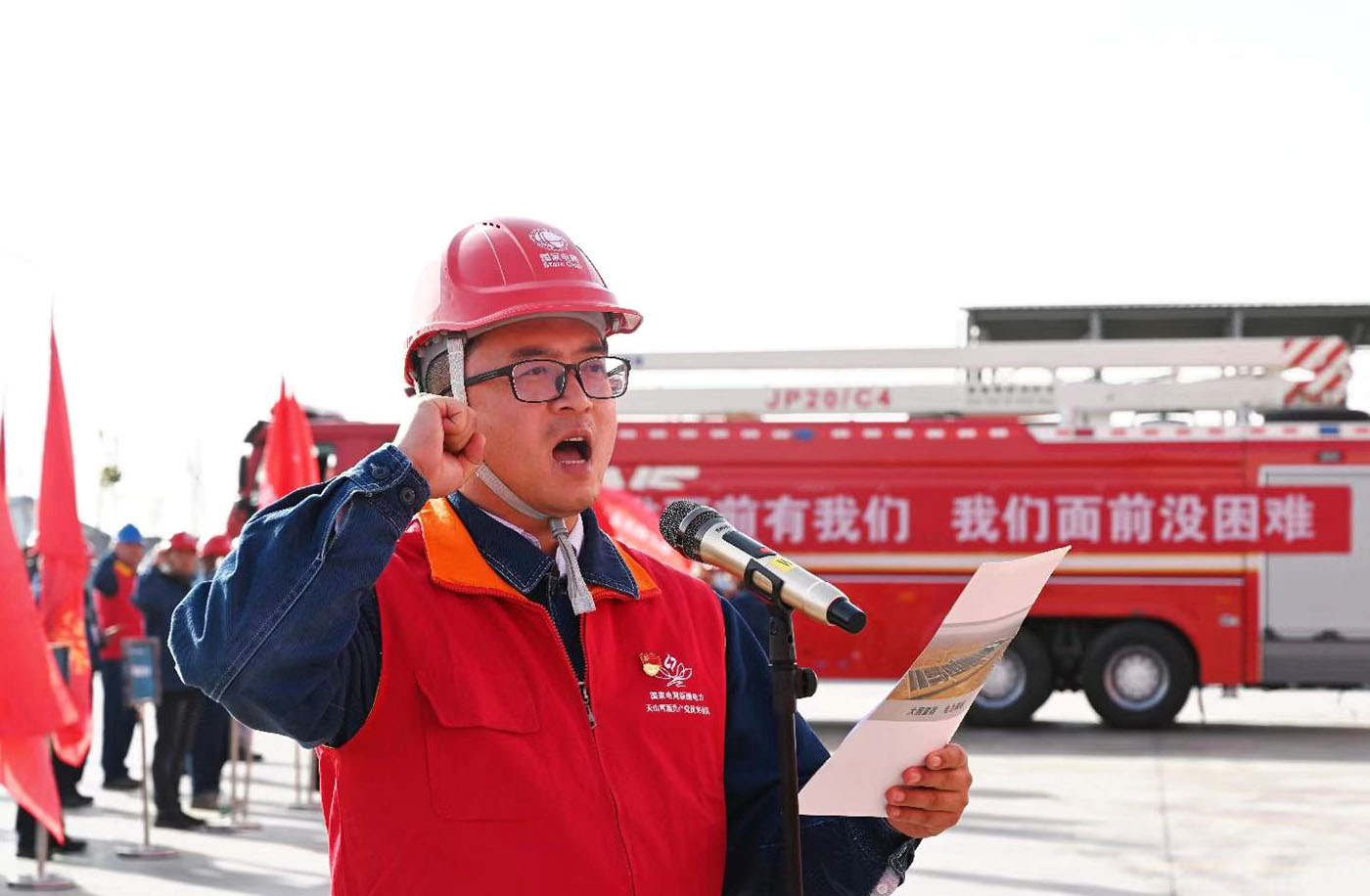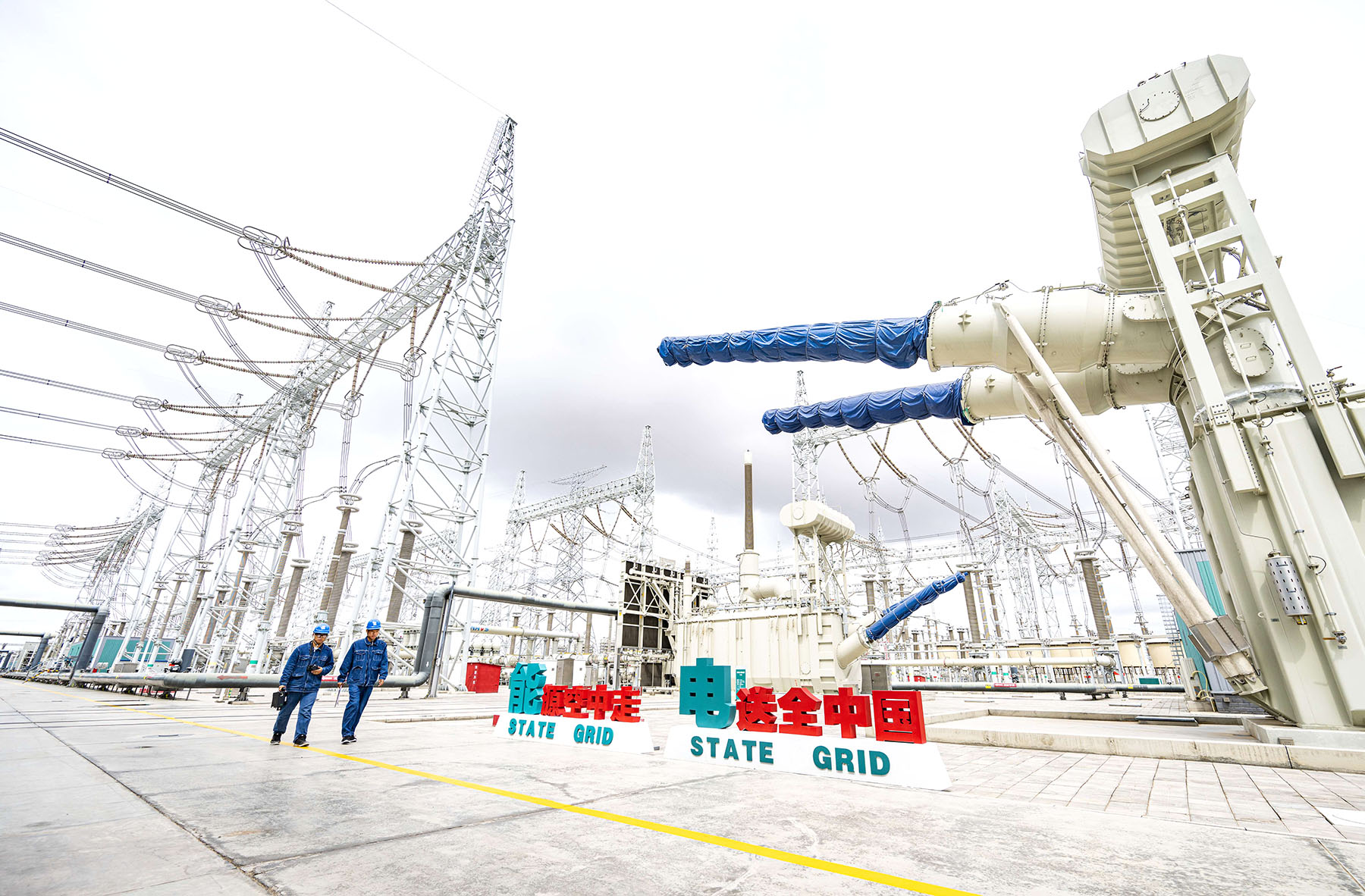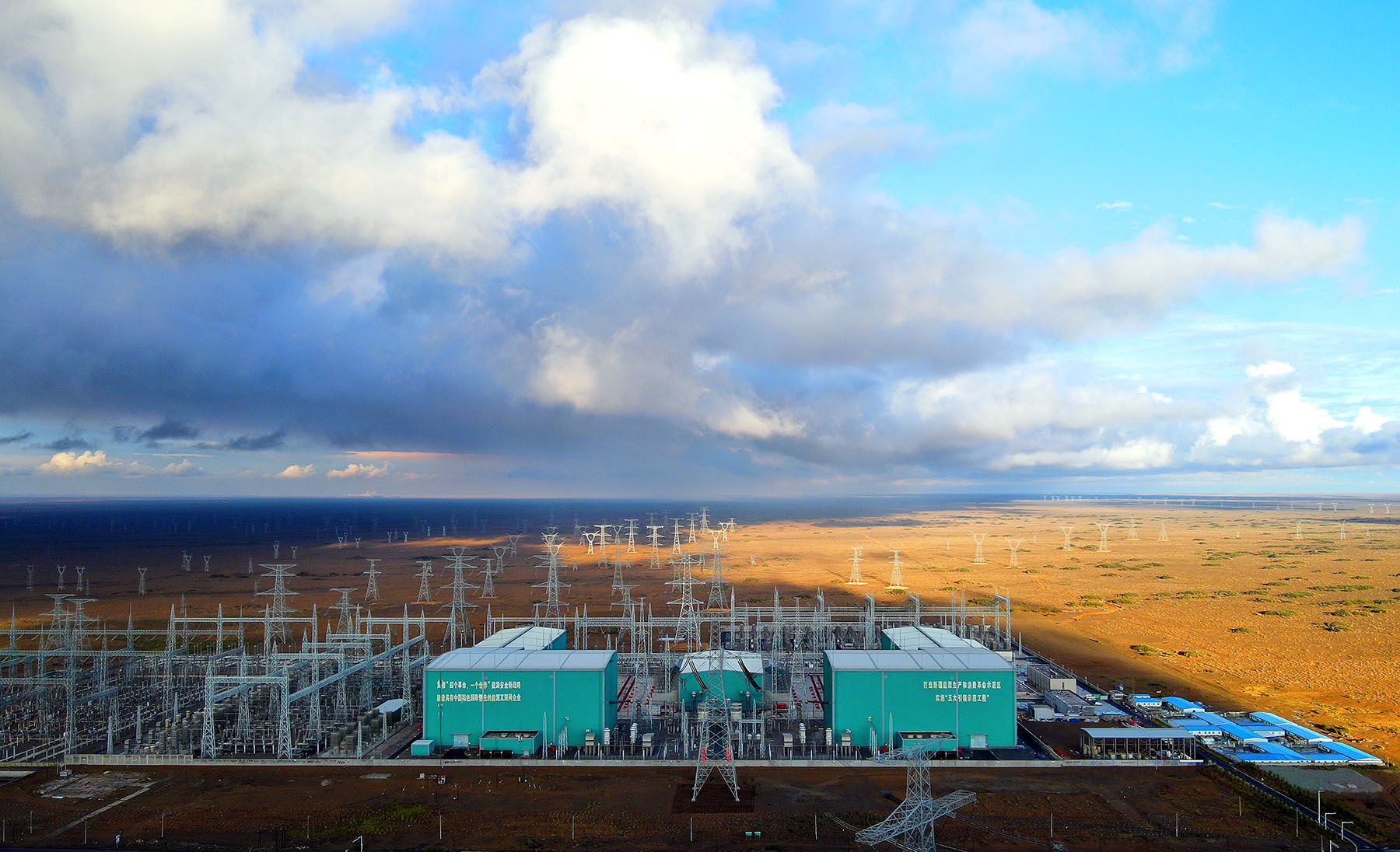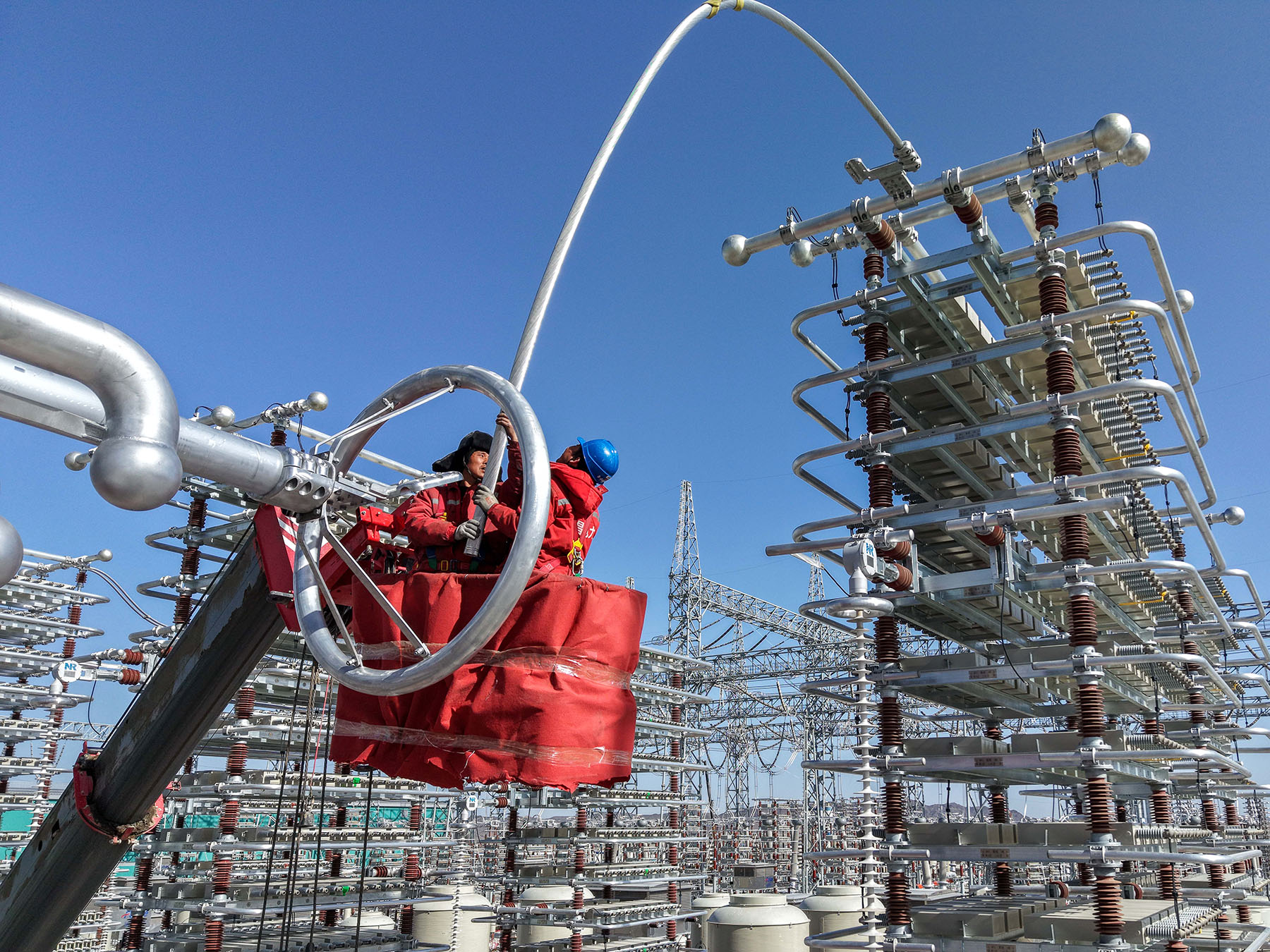Advances in green technology, improved electricity transmission infrastructure help region achieve goals

Boasting China's largest reserves of coal and solar resources and the second-largest wind energy potential, the Xinjiang Uygur autonomous region has undergone a remarkable metamorphosis into a major national energy producer and domestic electricity provider.
Under the 14th Five-Year Plan (2021-25), Xinjiang has been designated as a national base for wind and solar energy, coal production, oil and gas reserves, and a key electricity transmission corridor.
By the end of 2024, the region had transmitted more than 860 billion kilowatt-hours of electricity to other provincial-level regions — the equivalent of 260.15 million metric tons of coal — helping recipient area reduce 702.41 million tons of carbon dioxide emissions and 2.21 million tons of sulfur dioxide emissions.
Xinjiang's development comes at a crucial time. Eastern coastal regions face growing electricity shortages coupled with land constraints and environmental pressures that limit further coal power expansion.
READ MORE: Energy self-sufficiency pointer to secure future
Meanwhile, the rapid growth of artificial intelligence has triggered a substantial surge in electricity demand. As AI systems grow more sophisticated, their computational requirements have escalated exponentially, leading to massive energy consumption, particularly from power-hungry data centers running complex machine learning algorithms and large language models.
While Xinjiang's energy riches and rising demand from coastal areas have made it destined to become a key power supplier, the region's progress has been a gradual process, built on years of energy sector investment and construction, and the work of diligent professionals.

Sun, wind and watts
In Ruoqiang county, Bayingolin Mongolian autonomous prefecture, the construction of a large-scale comprehensive power generation base, with total investment of 71.8 billion yuan ($10 billion), is advancing according to plan.
The base has a planned installed capacity of nearly 19 million kilowatts, comprised of 4 million kW of wind power, 8.5 million kW of photovoltaic solar, and 3.96 million kW of thermal backup, supported by about 5 million kW of energy storage. Construction began on Sept 28, 2024.
Wang Liang, the on-site project manager of the China Three Gorges Corporation's Xinjiang branch, is in charge of building the base.
"Once the power generation base goes into operation, over 60 percent of its electricity generation will come from renewable green energy sources, and the utilization rate of new energy will exceed 90 percent," Wang said.
The base will bring a range of benefits to local development. According to a support plan for industries, the corporation has signed agreements with several companies to set up factories for development of industrial clusters and to boost local employment.

Wang Rui, 37, works on the construction project. He was transferred from Beijing to Ruoqiang in March 2024 to carry out preliminary project work with his colleagues.
"When I was a child, my interest in engineering construction was more about natural curiosity. After graduating from Wuhan University with a degree in hydraulic engineering, I decided to integrate my personal career aspirations with national strategic goals. It inspired me to commit myself to the clean energy sector, specializing in hydropower engineering and new energy development," Wang Rui said.
He also worked overseas for many years.
"My main workplace was in Africa, in a place close to the Sahara Desert. The conditions were rather tough. There we taught local residents how to use photovoltaic panels.
"In Ruoqiang, local residents pass on their experience in sand control methods to us and we integrate them into engineering construction," Wang added.
Wang described China's role in the development of the clean energy industry over the past 10 years as "epic".
"From a follower to a leader, China's voice and influence have grown significantly in the clean energy industry," he said. "As of the end of 2024, China's installed capacity of wind and solar power has increased over tenfold compared to a decade ago, with clean energy now accounting for approximately 60 percent of the nation's total power generation capacity. Notably, about half of the newly added electricity demand is being met by clean energy sources, demonstrating a continuous rise in the green energy of China's energy mix," Wang added.

Ensuring supply
Solar and wind power are inherently intermittent — their output fluctuates with weather conditions, making supply unpredictable.
On April 28, for example, due to extreme temperature variations, about 55 million people in Spain and Portugal — two countries that source about 80 percent of their electricity from solar and wind — suffered severe power outages that disrupted public transportation, and bank and internet services.
So how will Xinjiang respond to volatility and make the power grid more resilient?
The Xinjiang Fukang Pumped Storage Power Station of the State Grid Xinyuan Company addresses the issue by storing surplus energy when demand is low, said Lu Jiangang, deputy director of the engineering department.
The facility is composed of an upstream reservoir, water conveyance system, underground powerhouse system, ground switch station and a downstream reservoir. The elevation difference between the two reservoirs is approximately 400 meters.
"When electricity demand is low, the plant uses surplus power to pump water from a lower reservoir to an upper reservoir, converting electrical energy into stored energy. When demand peaks, water is released back to the lower reservoir through turbines, generating electricity," said Lu.
Yang Hongtao, chairman of the company, said: "Generally, the station pumps water from the downstream reservoir between 9 am and 3 pm, and generates power between midnight and 7 am, achieving about 80 percent round-trip efficiency."

The first of its kind in Northwest China, the power station commenced power generation in November 2023. It has a bidirectional and double regulation capacity of 2.4 million kW. As of May 14, the power station had operated nearly 15,000 hours and generated over 2.1 billion kWh of electricity.
Yang said the project was a breakthrough in providing flexible power regulation for the Xinjiang and Northwest China power grids, significantly advancing the transformation of abundant wind and solar resources into economic benefits. The facility plays a vital role in promoting Xinjiang's development of large-scale integrated energy bases that combine wind, solar, hydro, thermal, and energy storage.
"Compared with other storage methods, it boasts large-scale capacity, an exceptional safety record and a long operational lifespan," Yang added.
By balancing supply and demand in real time, the facility not only enhances grid reliability but also supports the large-scale adoption of intermittent renewables like wind and solar by about 2.6 billion kWh annually. That saves 165,000 tons of standard coal consumption, and reduces 496,000 tons of carbon dioxide emissions every year.
Lu said the station has six functions: peak shaving, frequency regulation, phase modulation, energy storage, spinning reserve, and black start.
"With the increasing integration of renewable energy capacity in Xinjiang, the demand for flexible power sources will continue to rise. After starting operations, the station has had a significant impact on the safe and stable operation of the power grid and the integration and consumption of renewable energy," Lu said.
However, the role of the power plant transcends grid stabilization. Lu said its construction had helped in the acquiring of valuable building experience and nurtured talent for future projects. Exchange programs and training sessions have since been held to share construction and operational expertise across Xinjiang.
The power station has also improved the fragile local environment — characterized by high altitudes and climate extremes of aridness and cold — through reservoir water evaporation that increases precipitation.
After conducting research, Lu and his colleagues carefully chose seeds and cultivated shrubs sourced from nearby regions, to increase the vegetation coverage and improve the local ecology.
"Two years after the station's operations began, wapitis (elks), foxes and wild boars reappeared and birds have settled in the reservoirs in summer, which is a sign of a better environment," Lu added.

Electrons racing
With growing power production in Xinjiang and rising electricity demand in central and eastern regions of China, long-distance power transmission has become imperative.
Located in the barren Changji Hui autonomous prefecture, the Changji converter station — the beginning of the Changji-Guquan Ultra-High-Voltage Direct Current Transmission Project — can transfer power to Xuancheng, Anhui province, within 0.01 second.
The project, which began operating on Sep 26, 2019, stretches through regions of Xinjiang, Gansu, Ningxia, Shaanxi, Henan and Anhui. Designed and constructed domestically, the project is the most technologically advanced ultrahigh voltage transmission project with the world's highest voltage level, the largest transmission capacity, and the longest transmission distance.
"Compared with alternating current, direct current offers constant voltage and direction, lower energy loss and superior efficiency for long-distance transmission," said Wang Hong, head of the Changji converter station. "From Xinjiang to Anhui, power transmission loss through the 3,293-kilometer project is approximately 5 percent."
When Wang Hong came to Changji to build the station in 2017, there was nothing but Gobi wilderness. Now the area has housing for station staff and the company has planted trees to improve the residential environment.
"In the past we had to commute by long-distance bus rides. Thanks to the new railway to Zhundong, we can reunite with our families in a safer manner," Wang said, adding you can create a "good life" in the tough environment.
Each year, the Changji-Guquan project transmits about 66 billion kWh of electricity annually to East China. This transmission reduces coal transportation by 30.24 million tons, equivalent to 25,000 freight trains (each with 20 carriages) and cuts soot emissions by 24,000 tons, sulfur dioxide by 149,000 tons, and nitrogen oxides by 157,000 tons.
In 2024, the power transmission volume of the project reached 68.3 billion kWh, accounting for approximately half of Xinjiang's total annual power transmission.
ALSO READ: Photovoltaic installed capacity forecast to grow 10% this year
It has ranked first among all ultrahigh-voltage projects in China for four consecutive years.
"The station delivery in 2024 is equivalent to 21.27 percent of Anhui's total power consumption in 2023 and 76 days' worth of the province's power demand," said Wang.
The 38-year-old has been working in ultrahigh-voltage power transmission for 14 years and this is the third such project he has been involved in.
"During my career, I have witnessed China's power industry develop and progress. I want to work hard, solve problems and provide people with better power services," he said.
Since its commissioning, the Changji converter station has cumulatively transmitted 340.2 billion kWh of electricity.
"We are developing a new generation of adaptive control algorithms, which could reduce transmission losses from 5 percent to below 3 percent in the future," Wang added.
Contact the writers at wangsongsong@chinadaily.com.cn


